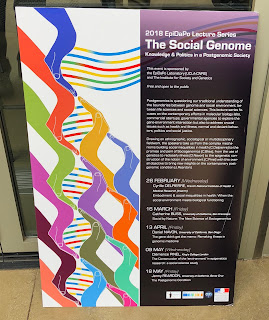Week 7: Neuroscience and Art
A few weeks ago, we learned that medical technologies owed their origins to the artists’ obsession with the human body and their anatomical illustrations (Vesna, 2012). Therefore, it is not surprising to learn that our current understandings of the brain should also emerge from the arts.
 |
| Training Your Brain |
If this theory is indeed correct, then hypnosis is very possible (Vesna, 2012). After all, there is already such thing as psychoanalysis. I learned in my cognitive psychology class that psychoanalysis is a type of therapy that aims to treat mental disorders by investigating the interaction of conscious and unconscious (Haslam, 2016).
 |
| Psychoanalysis |
 |
| Psychoanalytic Sub-theory: Topographic Model |
According to the Psychoanalytic sub-theory, there are three levels of the cognitive mind: (1) the Conscious (CS): any thoughts or feelings you are CURRENTLY aware of; (2) the Preconscious (PCS): emotion or impulse that you are unaware of but can become readily aware when you think about it; and (3) the Unconscious (UCS): the thoughts or desires that are repressed (Freud, 1940). It is believed that there is a “censor” that allows certain thoughts to go into consciousness under certain disguises, such as “slips of the tongue,” dreams or even symptoms like amnesia (Haslam, 2016). It would explain why people are sometimes mysteries to themselves (Brogaard, 2015).
There have been some controversies concerning the effectiveness of psychoanalysis for some people believe that the interpretation of dreams could be subjective and unreliable (Beystehner, 1998). More importantly, it raises the question of what is consciousness and does it really exist? (Vesna, 2012). Since unconsciousness itself is something that is unobservable, we cannot test the theory thus only hope that the technology can help shed some light on this.
Work Cited
Aeldra. Psychoanalysis: Difference between psychoanalysis and behaviorism. 3 Feb 2016. Photograph. 20 May 2018. Retrieved from https://www.youtube.com/watch?v=U4rAVayVF7M
Allen, Kimberly. Training Your Brain to Stay Fit. 16 May 2013. Photograph. 20 May 2018. Retrieved from https://www.healthandfitnesstalk.com/training-your-brain-to-stay-fit/
Beystehner, Kristen. “Psychoanalysis: Freud's Revolutionary Approach to Human Personality.” SAPA Project Test. August 1998. Retrieved from http://www.personalityresearch.org/papers/beystehner.html
Brogaard, Berit. “How Well Do You Really Know Yourself?” Psychology Today. 10 March 2015. Retrieved from https://www.psychologytoday.com/us/blog/the-mysteries-love/201503/how-well-do-you-really-know-yourself
Cohen, Mark. “Neuroscience.” Cole UC online. Youtube, 12 May 2012. Web. 20 May 2018.
Freud, Sigmund. The Psychical Apparatus. New York: Norton, 1940. Retrieved from http://siggyappsy.pbworks.com/w/file/fetch/68388002/the%20psychical%20apparatus 20130821_0001.pdf
Haslam, Nick. Introduction to Personality and Intelligence. SAGE publication, 2007. Print.
Haslam, Nick. Psychoanalytic Sub-theory: Topographic Model. 2007. Photograph. 20 May 2018.
Morin, Amy. “How to Train Your Brain to Think Differently.” Psychology Today. 10 Oct 2017. Retrieved from https://www.psychologytoday.com/us/blog/what-mentally-strong-people-dont-do/201710/how-train-your-brain-think-differently
Vesna, Victoria. “Conscious/Memory: Part 1.” Cole UC online. Youtube, 16 Nov 2012. Web. 20 May, 2018.
Vesna, Victoria. “Medicine and Art: Part 2.” Cole UC online. Youtube, 25 Oct 2012. Web. 27 Apr 2018.



Comments
Post a Comment